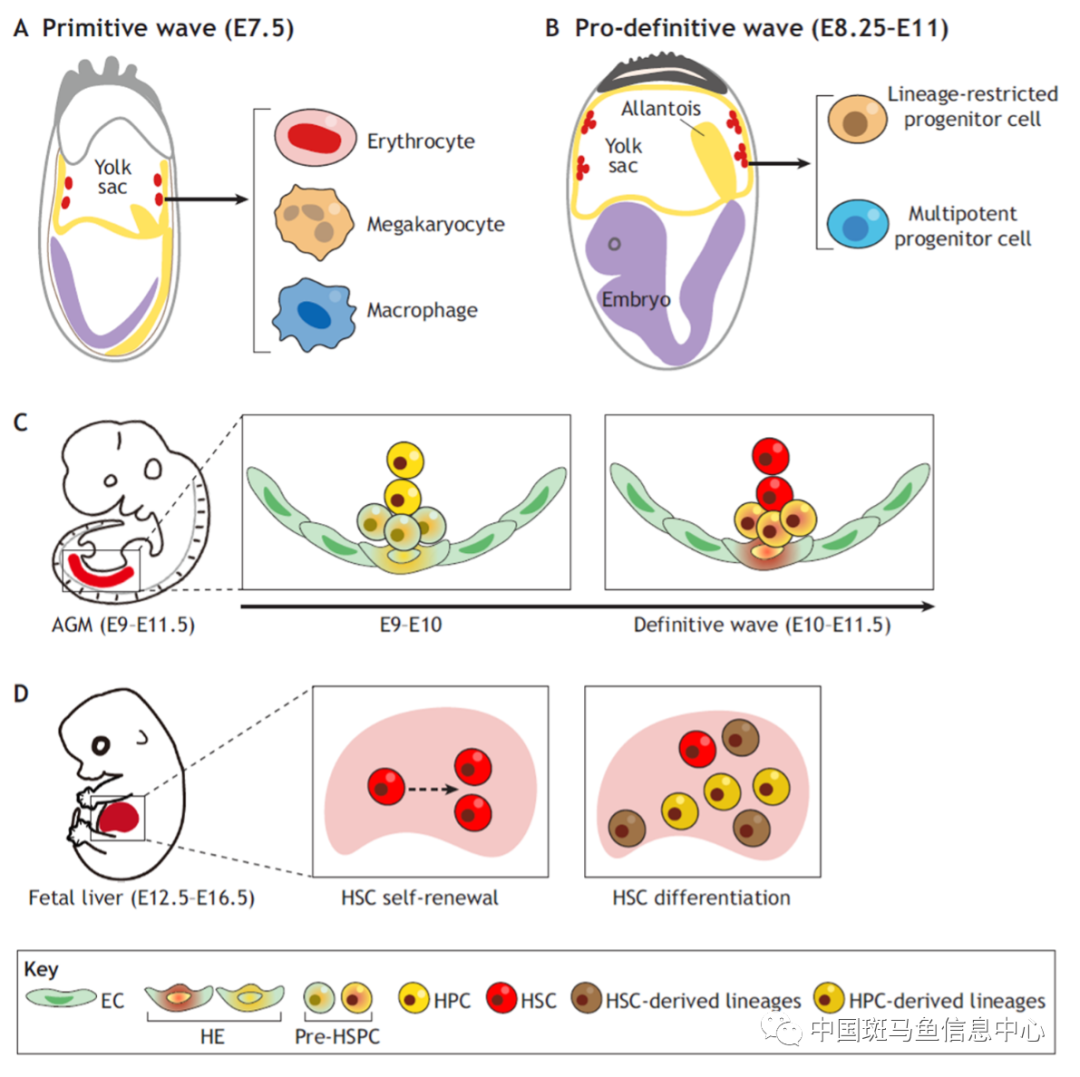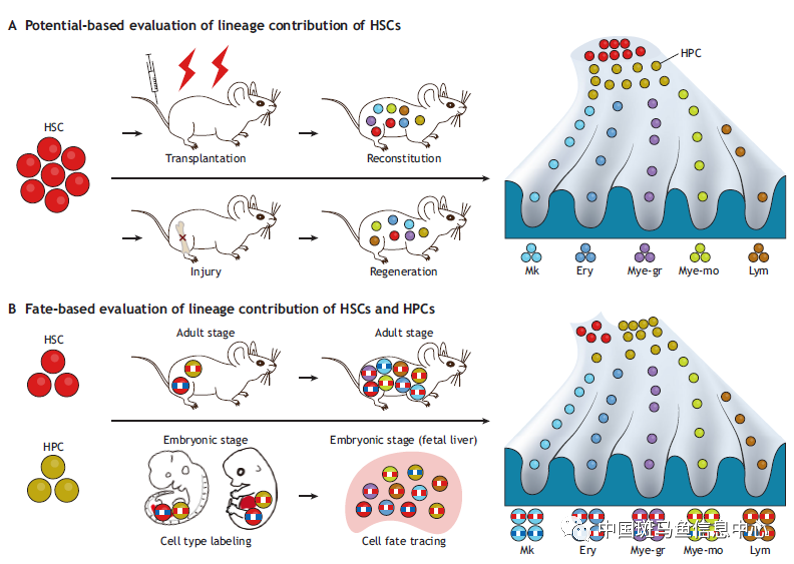
Source: China Zebrafish Information Center
As the source of blood, Hematopoietic stem cells maintain the stability of the Hematopoietic stem cell pool through self-renewal on the one hand, and generate various types of hematopoietic progenitor cells and mature blood cells through differentiation on the other hand [1]. The self-renewal ability and multidirectional differentiation ability of hematopoietic stem cells are strictly controlled to maintain the body's blood homeostasis. As early as 2000, Irving L. Weissman et al. proposed a Hematopoietic hierarchy model for hematopoietic stem cell differentiation [2]. In this structural model, hematopoietic stem cells at the top are differentiated to produce mature blood cells of various lineages. For a long time, hematopoietic stem cells with the ability of self-renewal and multidirectional differentiation have been considered as the main source of contribution to blood development. In recent years, with the application of single-cell multi-omics technology and high-throughput lineage tracer technology in the blood field [3-7], more and more studies have shown that classical hierarchical structure evaluates the differentiation potential of hematopoietic stem cells, and cannot truly reflect the fate of hematopoietic stem cells, so this complex process needs to be combed and updated in a timely manner.
Recently, a review paper titled "Revisiting the lineage contribution of hematopoietic stem and progenitor cells" was published in the prestigious journal Development. In this paper, the discovery and definition of hematopoietic stem cells and the classical hematopoietic hierarchical structure model are briefly reviewed, and the recent lineage differentiation characteristics of hematopoietic stem cells and hematopoietic progenitor cells revealed by single-cell multi-omics technology and new lineage tracing technology are highlighted.

Hematopoiesis is a dynamic and orderly process with strong spatial and temporal specificity. Embryonic hematopoietic development includes primary hematopoietic process and secondary hematopoietic process, hematopoietic stem cells are generated from secondary hematopoietic process, and a group of specialized endothelial cells in the aortic - gonadal - mesonephric region of embryo produce hematopoietic stem cells through endothelium-hematopoietic transformation process. Hematopoietic progenitor cells can be produced independently of hematopoietic stem cells through a similar transformation process at a time that precedes or coincides with the production of hematopoietic stem cells. Both embryonic hematopoietic stem cells and hematopoietic progenitor cells can generate mature blood cells through differentiation, forming the hematopoietic hierarchical structure model of the embryonic stage (Figure 1).

Figure 1. Developmental origin of hematopoietic stem cells and hematopoietic progenitor cells
Based on the results of transplantation experiments and colony formation experiments, hematopoietic stem cells are located at the top of the hematopoietic hierarchy and produce various hematopoietic progenitor cells and mature blood cells through stepwise differentiation. Due to the in vitro manipulation of hematopoietic stem cells and the preconditioning of the microenvironment, the classical hematopoietic hierarchy evaluates the differentiation potential of hematopoietic stem cells, and cannot truly reflect the fate of hematopoietic stem cells under physiological conditions. Recent studies have shown that from the embryonic stage to the adult stage, under normal physiological conditions, the production of mature blood cells is mainly contributed by hematopoietic progenitor cells, and blood development is mainly maintained by hematopoietic progenitors. Hematopoietic stem cells mainly differentiate into megakaryocytes and contribute less to mature blood cells of other lineages. Under stressful conditions such as damage to the blood system, hematopoietic stem cells generate blood cells of various lineages through stepped-differentiation to rebuild and maintain the stability of the regenerated blood system after damage (Figure 2).

Figure 2. Functional assessment of hematopoietic stem cells and hematopoietic progenitor cells
In summary, the classical hematopoietic hierarchy model is based primarily on nonphysiological functional assays (transplantation and clonal formation assays) that assess the differentiation potential of hematopoietic stem cells. With the application of lineage tracing strategies in physiological states, hematopoietic progenitor cells, rather than hematopoietic stem cells, were re-identified as the major contributors to embryonic and adult blood development. This review, based on recent research, helps redefine the origin and maintenance of embryonic and adult blood development under homeostasis and stress.
References:
1. Zhang, Y., et al., Hematopoietic Hierarchy - An Updated Roadmap. Trends Cell Biol, 2018. 28(12): p. 976-986.
2. Akashi, K., et al., A clonogenic common myeloid progenitor that gives rise to all myeloid lineages. Nature, 2000. 404(6774): p. 193-7.
3. Rodriguez-Fraticelli, A.E., et al., Clonal analysis of lineage fate in native haematopoiesis. Nature, 2018. 553(7687): p. 212-216.
4. Dignum, T., et al., Multipotent progenitors and hematopoietic stem cells arise independently from hemogenic endothelium in the mouse embryo. Cell Rep, 2021. 36(11): p. 109675.
5. Ulloa, B.A., et al., Definitive hematopoietic stem cells minimally contribute to embryonic hematopoiesis. Cell Rep, 2021. 36(11): p. 109703.
6. Patel, S.H., et al., Lifelong multilineage contribution by embryonic-born blood progenitors. Nature, 2022. 606(7915): p. 747-753.
7. Yokomizo, T., et al., Independent origins of fetal liver haematopoietic stem and progenitor cells. Nature, 2022. 609(7928): p. 779-784.